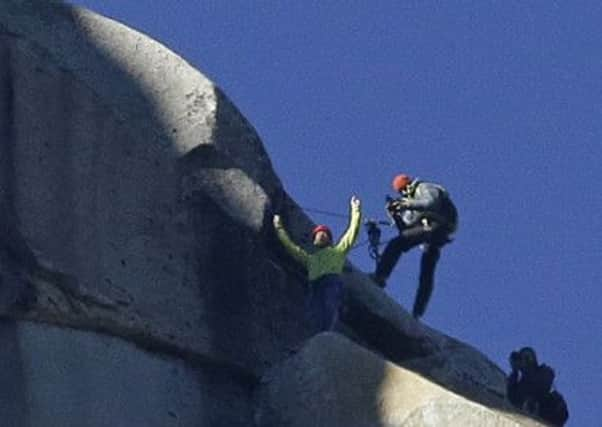Five of the best feats of human endurance


It was the use of superglue which pushed the achievements of two US climbers up another notch.
In the early hours of yesterday morning, after almost three weeks of climbing the sheer face of El Capitan in Yosemite National Park, Kevin Jorgeson and Tommy Caldwell reached the summit. They had used none of the usual mountaineering equipment, relying solo on strength and agility to get them to the top and earned their place in the Hall of Fame dedicated to feats of human endurance when they used a tube of superglue to stick their broken and blistered skin back together.
Sir Edmund Hillary and Sherpa Tenzing Norgay
Advertisement
Hide AdAdvertisement
Hide AdThese days anyone attempting an ascent of Everest is aided by lightweight tents, GPS radios and calorie packed rations. Things weren’t quite the same back in 1953. When Hillary and Tenzing conquered the 29,000ft mountain, their backpacks weighed more than three stone and they regularly had to defrost their leather boots over a camping stove. Before the final push to the top, when the tent had to be held down to prevent it blowing away in gale force winds, the pair secured legendary status by sitting down for a very 1950s dinner of sardines on biscuits and tinned apricots.
Ed Stafford
When the 34 year old former Army captain from Leicestershire announced he was going to walk the 4,000-mile length of the Amazon, Brazilian adventurers didn’t give the crazy Englishman good odds of surviving. If he managed not to catch a fatal bug, chances are, they said, a snake or jaguar would get him. Brave or foolish, Stafford set off in April 2008, reckoning the trek would take him a year. It took him almost two and a half, but after 859 days of continuous walking, Stafford, who along the way had been chased by a gang wielding machetes and had a botfly burrow into his head, proved the naysayers wrong.
Dashrath Manjhi
Aside from proving the indomitable nature of the human spirit, most feats of endurance are, well, pretty pointless. Not all, though. When Dashrath Manjhi watched his wife died due to lack of urgent medical treatment he was determined others shouldn’t suffer the same fate. The journey from his village in rural India to the nearest hospital wound 40 miles around the mountains, so Manjhi worked day and night for 22 years to hand carve a pass through the hills. He eventually finished in 1982 and the road, which was 30ft wide in places reduced the distance to a potentially life-saving nine miles.
Ben Lecomte
When Ben Lecomte became the first person to swim 3,716 miles across the Atlantic Ocean in 1998 his first words were ‘never again’. He wasn’t quite true to his word and more than 16 years later he’s about to go back in the water. This time it’s the Pacific, all 5,500 miles of it. His first swim was in memory of his father and raised £100,000 for charity, but this time he’s hoping to raise not just money, but awareness of the need to protect the world’s oceans.
Ranulph Fiennes
Advertisement
Hide AdAdvertisement
Hide AdBeginning his adventures in the 1960s, Fiennes has led expeditions up the White Nile, has crossed the North and South Poles and became the first person to cross the whole of the Antarctic on foot. However, it’s his most recent exploits which have cemented his iconic reputation. Four years ago he climbed Everest at 65, but that seemed small beer to his epic undertaking of completing seven marathons on seven continents in seven days in 2008. Ending in New York, running 26 miles in a none too shoddy five hours and 25 minutes, Fiennes’ only request at the finishing line was cup of hot chocolate and a chicken masala.